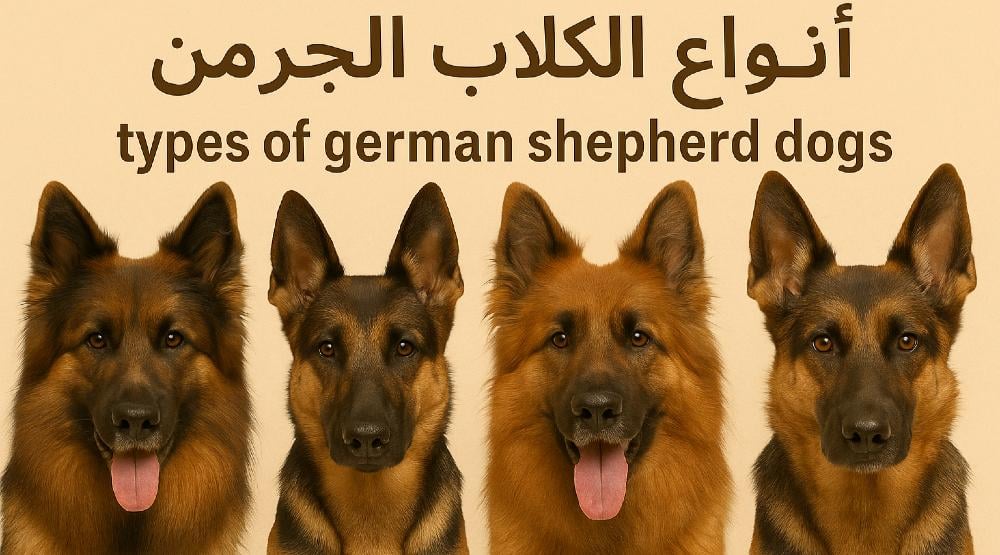Many of the world’s most popular and widely kept dog breeds are German Shepherds—especially in Saudi Arabia—thanks to their high intelligence, versatility in guarding and obedience, and extensive use by security forces. Many prospective owners seek precise information about the different types of German Shepherds, how each differs in appearance, temperament, and working role, and what a German Shepherd should eat. In this article, we’ll outline the main German Shepherd types and the characteristics of each, plus tips to help you choose the right line for your needs and daily routine.
What Is a German Shepherd?
The German Shepherd (or “GSD”) is one of the world’s most famous dog breeds, prized for its strong build, quick responsiveness, and high intelligence. These qualities make it a top choice for guarding, obedience training, police work, and search-and-rescue. Developed in Germany in the late 1800s, the goal was to create a robust, capable dog equally at home in rural and urban settings. While many people recognize the classic German Shepherd look, fewer know that multiple distinct lines exist within the breed—each with unique attributes in physique, temperament, and use. All share strong loyalty, rapid learning ability, and adaptability to disciplined training.
Main Types of German Shepherds
Though all belong to the same breed, German Shepherd lines differ according to their intended purpose—guarding, conformation shows, or police/military work—and display clear distinctions in build, coat, and general behavior. Here are the most prominent types bred worldwide:
Working Line (Police/Military)
- Also called the “line working” type, used for high-intensity tasks such as police or military service.
- Features a powerful, muscular frame, high energy, and exceptional endurance.
- Among the smartest and most trainable, with a primary focus on performance rather than appearance.
Show Line
- Bred for conformation competitions and aesthetic appeal.
- Exhibits a more pronounced rear angulation (sloping back) and thicker coat for a striking look.
- Requires extra grooming and nutritional care to maintain its appearance.
American Line
- Developed in the United States, this line resembles the show type but with a calmer temperament more suited to family life.
- Typically has a more moderate slope in the topline and slightly longer coat.
- Less aggressive and highly affectionate with children, making it a popular household companion.
Czech (East European) Working Line
- Originates from Czech military breeding programs, known for exceptional strength and quick obedience.
- Compact, muscular build optimized for challenging environments and sustained work.
- Among the most professional German Shepherds under high-pressure conditions.
Understanding these lines helps you select the right type based on your primary purpose—security work, sport training, or a family pet.
How to Choose the Right Line for You
When considering a German Shepherd, don’t judge solely by the classic look or the breed’s fame. Learn about each line’s traits and match them to your lifestyle and goals:
Define Your Purpose
- For guarding or security roles, a working line (German or Czech) is ideal.
- For a family companion, especially around children, the American or show line is generally calmer.
Assess Your Time for Training
- Working lines require daily, intensive training and energy outlets.
- If you lack time for rigorous activity, a show or American line may suit you better, as they demand less discipline and exercise.
Consider Your Living Environment
- Apartment dwellers or those in hot climates may struggle with high‑energy or thick‑coated lines.
- Show lines with dense fur need good ventilation and cooler surroundings.
Ask About Genetic Health
- Before purchase, confirm the puppy’s pedigree is clear of hereditary issues like hip dysplasia or eye problems.
- Review vaccination records to ensure a healthy start.
Choosing the right German Shepherd line ensures a rewarding ownership experience and minimizes future behavioral or health issues.
What Should a German Shepherd Eat from Our Store?
Trappy Bites Variety Pack for Dogs
Our Variety Pack delivers a balanced selection of natural meals and healthy broths designed to support your dog’s daily well‑being. It includes eight different items combining high‑quality proteins, wholesome natural ingredients, and flavors most dogs love—without preservatives or artificial additives:
- A mix of meats (chicken, beef, goat, duck, rabbit, fish) for digestive and immune support
- Gently cooked recipes to preserve nutritional value
- Rich in amino acids, omega‑3s, and essential minerals
- Suitable for dogs of all ages and breeds
- Natural broths to boost hydration and appetite, especially in hot weather or after exercise
Trappy Bites Raw‑Boosted Breakfast Pack
For a natural, protein‑rich start to the day, our Raw‑Boosted Breakfast Pack offers thirty preportioned raw meals that fuel energy and vitality:
- Diverse flavors to keep mealtime exciting and prevent dietary boredom
- Fully natural ingredients with no grains or artificial additives
- Nutrients supporting bone, muscle, and immune health
- Perfect for dogs with food sensitivities
- Delicious taste that encourages consistent eating
German Shepherds are one of the most versatile and accomplished breeds—exceling in work, protection, and home life. With multiple lines available, understanding the subtle differences in appearance, behavior, and needs is key. The right choice depends on your intended use, training commitment, and living situation. Armed with this knowledge, you’ll enjoy a fulfilling relationship with your German Shepherd and unlock its natural abilities to the fullest.
Frequently Asked Questions
What are the drawbacks of a German Shepherd?
They shed heavily, require intensive training and physical activity, and can be prone to certain health issues (e.g., joint problems, eye disorders).
Are German Shepherds loyal?
Yes. German Shepherds are among the most devoted breeds, fiercely protective of their family, and make exceptional guard dogs.

